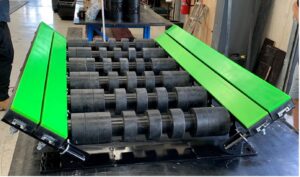Crusher wear parts are an integral component of a crushing operation, with the wear parts being designed to withstand extreme abrasive forces and impacts encountered during the crushing operation. Wear parts, such as: jaw plates, cone mantles, concaves, liners and impactor blow bars bear the brunt of the crushing process.
There are many factors that influence the performance of these wear parts, such as the metal content in the wear part, the rock geology and even the size of the rock. The following information aims to provide the significance of the different manganese and metal content within the wear parts and how this can influence what to choose for your crushing applications.
Manganese
Manganese is a versatile metal with properties that are ideal for crusher wear parts. Manganese has high strength, hardness, and is impact resistance, making it a crucial ingredient in crusher wear parts. Notably, manganese also demonstrates exceptional work-hardening ability, meaning the material actually increases in hardness and strength when subjected to the forces that occur during the crushing process. The most common grades of manganese utilised in crusher wear parts vary, but in a general sense they are:
- 13% Manganese: The 13% manganese grade represents the foundational level widely utilised in crusher wear parts. It offers moderate wear resistance and presents a cost-effective solution for numerous crushing applications. This grade is suitable for low-impact crushing environments and commonly employed in general-purpose wear parts, where abrasive conditions are not severe. This is a common grade in many entry-level OEM wear-parts.
- 18% Manganese: Advancing from the baseline grade, the 18% manganese grade, provides enhanced wear resistance compared to lower grade counterparts. 18% manganese excels in moderate to high-impact crushing environments and finds application across a wide range of wear parts, including jaw plates, cone mantles, and impactor blow bars. At ACBG, this grade of manganese is typically our lowest grade of manganese content in our crushing wear parts as it strikes an excellent balance between cost and wear life.
- 21% Manganese: Engineered for extreme wear resistance, this grade is purposefully designed to withstand the most demanding crushing conditions and can typically achieve a work-hardened state much faster than other grades. 21% exhibits exceptional performance in high-impact and abrasive environments, thereby offering extended wear life in the right conditions. We offer a range of products in 21% manganese.
Chrome, Ceramic, and Martensitic Content in Crusher Wear Parts
On top of manganese offering excellent work-hardening properties and wear resistance, the addition of chrome, ceramics, and martensitic steel are frequently incorporated to provide further reinforcement and protection in specific operating requirements.
- Chrome. Known for its exceptional hardness and resistance to abrasion, is often used as a complementary material in manganese wear parts. Chrome acts as a shield, forming a hard surface layer that resists abrasion and reduces material build-up. By introducing chrome into the composition of the wear parts, we gain increased wear resistance, especially in highly abrasive crushing environments.
- Ceramic materials. Materials such as titanium carbide and zirconia-based compounds offer superior hardness and exceptional wear resistance, making them ideal for certain high-impact crushing applications. These ceramic inserts or coatings, strategically placed in critical areas of maximum wear, provide added protection where its often needed, therefore prolonging the lifespan of the parts.
- Martensitic steel on the other hand, acts as a tough barrier, absorbing and dissipating the energy of high-impact forces, ensuring the integrity of the manganese content. Martensitic steel is often used in certain grades of impactor blow bars to withstand heavy impact loads and prevent premature failure. When combined with manganese, these elements and materials work in synergy to reinforce the overall wear resistance and performance of crusher wear parts.
Selecting the Appropriate Grade
The selection of the optimal metal composite for crusher wear parts necessitates a comprehensive understanding of the specific crushing application. Factors including feed material characteristics, crushing types, and product requirements significantly influence the grade choice. At Australian Crushing and Belting Group, we have a wide selection of products suitable for a large variety of crushing requirements across quarrying, mining, recycling and construction. We can offer a range of product types to trial in your crushing operations to achieve greater life out of your wear parts.
Call us today to discuss your requirements.






